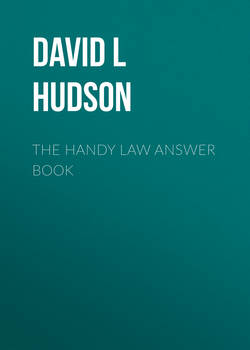Читать книгу The Handy Law Answer Book - David L Hudson - Страница 8
На сайте Литреса книга снята с продажи.
Introduction
ОглавлениеLaw in the United States is ubiquitous and unique. Pick up a newspaper or turn on the television and you will confront the law or the legal system. Recently, the leading stories in the news media involved the possibility of new federal healthcare legislation, a pending ruling by the U.S. Supreme Court on campaign finance, the implementation of behavioral profiles for would-be terrorists, and a gruesome murder. Obviously, all of these—pending legislation, a future court ruling, profiling possible terrorists, or criminals and a crime—directly trigger the legal system.
The American legal system is unique for many reasons, most notably its Constitution—the grand experiment created in secret at those fabled meetings during the summer of 1787 in Philadelphia, Pennsylvania. The founding fathers—a sizeable number of whom were lawyers—created a legal system that is the envy of the world. It separated power between three branches of government, divided authority between a central, federal government and various state governments, and even provided for measures of individual freedom, particularly after the addition of the first ten amendments known as the Bill of Rights.
Former U.S. Supreme Court Justice Oliver Wendell Holmes Jr., who is considered one of the country’s great jurists, once wrote: “The rational study of law is still to a large extent the study of history.” On another occasion, he wrote: “The law embodies the story of a nation’s development through many centuries, and it cannot be dealt with as if it contained only the axioms and corollaries of a book of mathematics.”
For this reason, The Handy Law Answer Book begins with an examination of the history and development of the Constitution—the fundamental blueprint of the legal system—and a discussion of constitutional law. The states passed the U.S. Constitution only upon the promise that Congress would pass certain provisions protecting individuals from the powers of the new central government. These first ten amendments to the U.S. Constitution are what James Madison called “the great rights of mankind”—the Bill of Rights. The next chapter of this book examines the various provisions of the Bill of Rights.
Chapter Three, The Court System, explains the structure of the judicial branch in both the federal and state systems. It examines not only the highest court—the so-called “Court of Last Resort”—but also various state courts. In Chapter Four, readers will learn more about lawsuits and lawyers, including how a lawsuit starts, how one becomes a lawyer, and how to choose a lawyer.
Many people are afraid of the legal system, baffled by its jargon, mystified by its complexity, or upset at its outcomes. But, the law often serves as the galvanizing force for social change. As Supreme Court Justice Robert Jackson once wrote: “Any legal doctrine which fails to enlist the support of well-regarded lawyers will have no real sway in this country.”
The text then examines various substantive areas of law—not all areas of law, but those most commonly encountered by people in their everyday lives. These include criminal law, credit and bankruptcy, employment law, family law, and personal injury law. People often face criminal charges, encounter financial difficulty, suffer a job loss, endure a painful divorce, embark on a beautiful marriage, or suffer an injury in everyday life. These chapters will explain the legalities involved in all of these areas.
In the criminal field, readers will learn how a criminal case moves from arrest to arraignment to trial. You will learn about felonies and misdemeanors, bail, juvenile justice, and selecting juries. Regarding credit and bankruptcy, you will learn about credit records, credit cards, Chapters 7 and 13 bankruptcies, and the relatively new Bankruptcy Abuse Prevention and Consumer Protection Act of 2005. In employment law, you will read about employment contracts, the employment-at-will doctrine, just-cause clauses, discrimination lawsuits, and the Equal Employment Opportunity Commission. Finally, in tort law, you will discover various causes of action, the elements of a slip-and-fall case, the different type of damages in lawsuits, and the question of tort reform.
Recall the uniqueness of the American legal system. One of the more fascinating aspects of this system is its federalism—the allocation of power between the federal and state governments. Under our legal system, states are granted an impressive degree of discretion to develop their own laws and principles as long as they comport with the fundamental baselines of the U.S. Constitution. In other words, the workers compensation system in Tennessee can differ from the workers compensation system in Louisiana, as long as neither violates the U.S. Constitution. Similarly, personal injury law in California differs from personal injury law in Massachusetts. Different states have different grounds for divorce and different requirements for marriage.
The Handy Law Answer Book follows the format of the “Handy” series with its easily accessible question-and-answer format that provides an overview, a history, leading principles, seminal court rulings, and practical information.
In addition, the book features an array of sidebars titled “LegalSpeak” that seek to provide the actual language of laws and court rulings or to explain difficult legal concepts.
Unless otherwise indicated, the “LegalSpeak” quotes are taken from U.S. Supreme Court decisions.
The Handy Law Answer Book also includes three appendices that explain case and statute citations, provide a list of helpful online resources, and include the full text of the U.S. Constitution. You will also find a helpful glossary of legal terms and an index.
I hope readers enjoy the book as much as I did putting it together.
David L. Hudson, Jr.
